
Orb-weaver spiders are members of the spider family Araneidae. They are the most common group of builders of spiral wheel-shaped webs often found in gardens, fields, and forests. The English word "orb" can mean "circular", hence the English name of the group. Araneids have eight similar eyes, hairy or spiny legs, and no stridulating organs.

Octavius Pickard-Cambridge FRS was an English clergyman and zoologist. He was a keen arachnologist who described and named more than 900 species of spider.

Gasteracantha is a genus of orb-weaver spiders first named by Carl Jakob Sundevall in 1833. Species of the genus are known as spiny-backed orb-weavers, spiny orb-weavers, or spiny spiders. The females of most species are brightly colored with six prominent spines on their broad, hardened, shell-like abdomens. The name Gasteracantha is derived from the Greek gaster (γαστήρ), meaning "belly, abdomen", and akantha (άκανθα), meaning "thorn, spine". Spiny-backed orb-weavers are sometimes colloquially called "crab spiders" because of their shape, but they are not closely related to the true crab spiders. Other colloquial names for certain species include thorn spider, star spider, kite spider, or jewel spider.

Zygiella is a genus of orb-weaver spiders first described by F. O. Pickard-Cambridge in 1902. In 2015, Parazygiella was determined to be a taxonomic synonym of Zygiella, and its species were moved to Zygiella.

Ordgarius is a genus of orb-weaver spiders first described by Eugen von Keyserling in 1886. Adult females of the genus are bolas spiders, capturing their prey with one or more sticky drops at the end of a single line of silk rather than in a web. Males and juvenile females capture their prey directly with their legs.

Micrathena, known as spiny orbweavers, is a genus of orb-weaver spiders first described by Carl Jakob Sundevall in 1833. Micrathena contains more than a hundred species, most of them Neotropical woodland-dwelling species. The name is derived from the Greek "micro", meaning "small", and the goddess Athena.
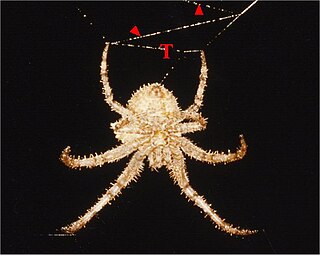
Kaira, sometimes called frilled orbweavers, is a mostly neotropical genus of orb-weaver spiders first described by O. Pickard-Cambridge in 1889. It includes sixteen described species that occur from South America up to the southern and eastern USA. It is presumably related to Aculepeira, Amazonepeira and Metepeira.
Chorizopes is a genus of orb-weaver spiders first described by O. Pickard-Cambridge in 1871. Though it belongs to the orb weaver family, these spiders move through leaf litter preying on other spiders rather than spinning webs. The original name was "Chorizoopes", but the emendationChorizopes by Tamerlan Thorell is now protected by usage.

Dolichognatha is a genus of tropical and subtropical long-jawed orb-weavers that was first described by Octavius Pickard-Cambridge in 1869. Originally placed with the Archaeidae, it was transferred to the Araneidae in 1967, and to the Tetragnathidae in 1981.
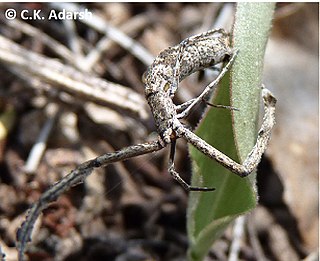
Miagrammopes is a genus of cribellate orb weavers first described by Octavius Pickard-Cambridge in 1870. These spiders have a unique shape and only four of their original eight eyes. They spin a single line of web, actively watching and jerking the line to catch their prey.
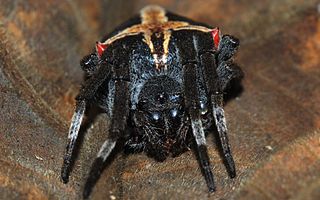
Parawixia is a genus of orb-weaver spiders first described by F. O. Pickard-Cambridge in 1904. Most species are found in the Neotropics but one species, Parawixia dehaani, is found in Australasia and tropical Asia as far west as India.
Pickardinella is a monotypic genus of Mexican long-jawed orb-weavers containing the single species, Pickardinella setigera. The species was first described by Frederick Octavius Pickard-Cambridge under the name Leucauge setigera, and was moved to its own genus in 1951. Physically, they resemble members of Opadometa and Leucauge. Males are very small, only growing up to about 2 millimetres (0.079 in) long. A female has never been found.
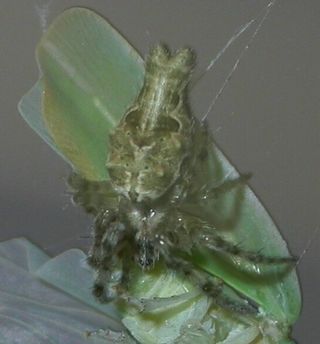
Allocyclosa is a genus of orb weaver spiders that contains only one species, Allocyclosa bifurca. It was first described in 1887 by McCook under the name Cyrtophora bifurca, and was transferred to its own genus in 1999. It is the only Cyclosa species north of Mexico to have a forked rear tip of the abdomen hence the name bifurca, Latin for "two-pronged". The forked tip of the abdomen, bearing two humps shaped like the letter M, is a defining feature in both males and females, though it is similar to features present in certain Cyrtophora species. Both sexes are a grey-green color, though only females have an area of red on their underside between the epigynum and the spinnerets. Females are much larger than males, ranging from five to nine millimeters, while males range from two to three millimeters. Males appear to be very uncommon, but they are probably often overlooked by collectors due to their small size. In a 1977 study by Levi, only two of the nearly 350 specimens that were positively identified as Cyrtophora bifurca were males. This is a very unusual distribution; a second, less likely explanation that has been proposed is that females of the species, which have less prominent genitalia compared with those of other members of the orb-weaver family, may be parthenogenic, are able to reproduce without the help of males. Like most other members of Araneidae, these spiders build orb webs, six to eight inches in diameter, but employ an unusual form of protective mimicry. Females often sit in the middle of a vertical row of web decoration that include egg sacs and wrapped prey. Because the spider and the egg sacs have a similar color and shape, it is difficult to distinguish the egg sacs from the spider itself.
Edricus is a genus of orb-weaver spiders first described by O. Pickard-Cambridge in 1890. As of April 2019 it contains only two species.
Milonia is a genus of Southeast Asian orb-weaver spiders first described by Tamerlan Thorell in 1890.
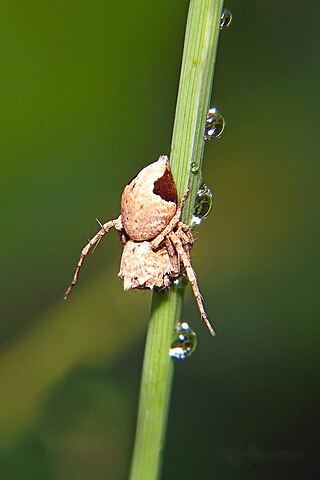
Hamataliwa is a genus of lynx spiders that was first described by Eugen von Keyserling in 1887.
Metabus is a genus of long-jawed orb-weavers that was first described by Octavius Pickard-Cambridge in 1899.
Witica is a genus of orb-weaver spiders first described by Octavius Pickard-Cambridge in 1895. As of April 2019 it contains only three species.
Ariston is a genus of cribellate orb-weavers first described by Octavius Pickard-Cambridge in 1896.

Hoploclonia gecko is a relatively small, spiny and darkly colored stick insect species that is native to the northwest of Borneo.













